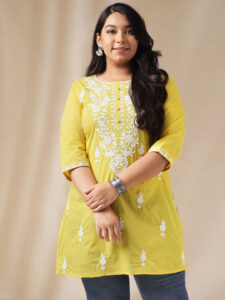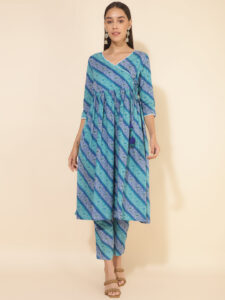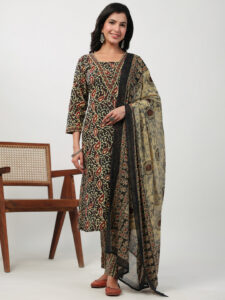The history of textiles in India has been long and wide, dating all the way back to the Indus Valley Civilization. In today’s world, the variety of textiles in India features more than 30 fabrics spread across 29 states and 7 union territories. We can thank it all to the richness of our heritage, a treasure trove of traditions, intricate craftsmanship, and timeless elegance.
Even if we look at it globally,
Indian Ethnic Wear, especially ones which are crafted from Indian Fabrics, are some of the most sought-after garments. So, in celebration of the rich fabrics spanning millennia, let’s take a deep dive through a few of them. Let’s Go!
Chikankari


Lucknow is one of the ancient cities, and it deserves the first spot on our list due to it being the original place for Chikankari. This intricate hand embroidery was first introduced by Nur Jahan in the Mughal Dynasty. A well-known embroiderer, she was passionate about this craft. In the past it was embroidered on muslin cloth with mirror work, pearls, or mukaish, nowadays, you can find Chikankari work on a
cotton kurta, a silk dress, or even a georgette shirt.
Janasya’s Chikankari collection too is similar to the ancient threadwork, an affordable and modern variation. Our
Indian Ethnic Wear Kurtis are a good alternative to the traditional work, and you too can feel a part of the Nur Jahan squad. Pair it up with some denim and you are good to go!
Chanderi


Chanderi from Madhya Pradesh is often called the gem of textiles in India, and it is not difficult to see why. Started from a small community in a town from the Vedic Period, the hand weaving technique is unique to just that region. The artisans of Madhya Pradesh intertwine Zari, silk, and cotton yarns with fabric to create intricate designs, perfect for
festive ethnic wear.
The
Chanderi Silk Kurti Set from Janasya also emulates the authentic Chanderi work, complete with embroidery on the yoke to create magic. Accessorizing it with minimal jewelry will make sure that the spotlight remains on the
Kurti Palazzo Set.
Bandhani


Bandhani is a form of tie-dying, where the creator plucks a small section of the fabric and ties it before dunking in the dye. The art of this practice has been part of the Indian Subcontinent for centuries, dating back all the way to Indus Valley Civilization, where dyeing was extremely common. Nowadays, you can find authentic Bandhani ethnic wear
suits set for women in Rajasthan, Sindh, Punjab, Tamil Nadu, and Gujarat.
You can find
Bandhani print kurta for women here at Janasya too, echoing the traditional fabrics to a T.
Batik


Said to be originating on the Java Island of Indonesia, Batik is a textile work that has admirers from around the globe. While traveling across the silk road, Batik created a place for itself in the regions of Gujarat, mainly Kutch. The practice is time consuming and intricate, where artisans must wax, dye, and scrap to create beautiful patterns.
These
3 piece suit for women from Janasya mirror the intricate work, emulating the ethnic feel to it.
Ikat


Ikat is one fabric that is unique among the unique. The threads are first dyed and then woven together, creating an abstract pattern that is beloved. The famous blurring effect is created by the artisan’s precise mathematical precision, transforming a simple woven fabric into a distinctive work. While the exact origin of this practice is unknown, Ikat ethnic wear suits for women can be found in regions of Pochampally in Telangana, Bhagalpur in Bihar and Sambalpur in Orissa.
The Ikat
festive ethnic wear from Janasya resemble the intricate fabric, echoing the blurry designs and precise craft.
And with that the trip across India comes to an end. We are sure that you too feel the pride for our heritage when looking at the different cultures and craftsmanship of the artisans. Which one is your favorite? Let us know in the comments and visit janasya.com for more such
Indian Ethnic Wear.
Read more: VIBRANT COLOR-COORDINATED OUTFITS FOR EVERY DAY OF THE WEEK

 Lucknow is one of the ancient cities, and it deserves the first spot on our list due to it being the original place for Chikankari. This intricate hand embroidery was first introduced by Nur Jahan in the Mughal Dynasty. A well-known embroiderer, she was passionate about this craft. In the past it was embroidered on muslin cloth with mirror work, pearls, or mukaish, nowadays, you can find Chikankari work on a cotton kurta, a silk dress, or even a georgette shirt.
Janasya’s Chikankari collection too is similar to the ancient threadwork, an affordable and modern variation. Our Indian Ethnic Wear Kurtis are a good alternative to the traditional work, and you too can feel a part of the Nur Jahan squad. Pair it up with some denim and you are good to go!
Lucknow is one of the ancient cities, and it deserves the first spot on our list due to it being the original place for Chikankari. This intricate hand embroidery was first introduced by Nur Jahan in the Mughal Dynasty. A well-known embroiderer, she was passionate about this craft. In the past it was embroidered on muslin cloth with mirror work, pearls, or mukaish, nowadays, you can find Chikankari work on a cotton kurta, a silk dress, or even a georgette shirt.
Janasya’s Chikankari collection too is similar to the ancient threadwork, an affordable and modern variation. Our Indian Ethnic Wear Kurtis are a good alternative to the traditional work, and you too can feel a part of the Nur Jahan squad. Pair it up with some denim and you are good to go!

 Chanderi from Madhya Pradesh is often called the gem of textiles in India, and it is not difficult to see why. Started from a small community in a town from the Vedic Period, the hand weaving technique is unique to just that region. The artisans of Madhya Pradesh intertwine Zari, silk, and cotton yarns with fabric to create intricate designs, perfect for festive ethnic wear.
The Chanderi Silk Kurti Set from Janasya also emulates the authentic Chanderi work, complete with embroidery on the yoke to create magic. Accessorizing it with minimal jewelry will make sure that the spotlight remains on the Kurti Palazzo Set.
Chanderi from Madhya Pradesh is often called the gem of textiles in India, and it is not difficult to see why. Started from a small community in a town from the Vedic Period, the hand weaving technique is unique to just that region. The artisans of Madhya Pradesh intertwine Zari, silk, and cotton yarns with fabric to create intricate designs, perfect for festive ethnic wear.
The Chanderi Silk Kurti Set from Janasya also emulates the authentic Chanderi work, complete with embroidery on the yoke to create magic. Accessorizing it with minimal jewelry will make sure that the spotlight remains on the Kurti Palazzo Set.

 Bandhani is a form of tie-dying, where the creator plucks a small section of the fabric and ties it before dunking in the dye. The art of this practice has been part of the Indian Subcontinent for centuries, dating back all the way to Indus Valley Civilization, where dyeing was extremely common. Nowadays, you can find authentic Bandhani ethnic wear suits set for women in Rajasthan, Sindh, Punjab, Tamil Nadu, and Gujarat.
You can find Bandhani print kurta for women here at Janasya too, echoing the traditional fabrics to a T.
Bandhani is a form of tie-dying, where the creator plucks a small section of the fabric and ties it before dunking in the dye. The art of this practice has been part of the Indian Subcontinent for centuries, dating back all the way to Indus Valley Civilization, where dyeing was extremely common. Nowadays, you can find authentic Bandhani ethnic wear suits set for women in Rajasthan, Sindh, Punjab, Tamil Nadu, and Gujarat.
You can find Bandhani print kurta for women here at Janasya too, echoing the traditional fabrics to a T.

 Said to be originating on the Java Island of Indonesia, Batik is a textile work that has admirers from around the globe. While traveling across the silk road, Batik created a place for itself in the regions of Gujarat, mainly Kutch. The practice is time consuming and intricate, where artisans must wax, dye, and scrap to create beautiful patterns.
These 3 piece suit for women from Janasya mirror the intricate work, emulating the ethnic feel to it.
Said to be originating on the Java Island of Indonesia, Batik is a textile work that has admirers from around the globe. While traveling across the silk road, Batik created a place for itself in the regions of Gujarat, mainly Kutch. The practice is time consuming and intricate, where artisans must wax, dye, and scrap to create beautiful patterns.
These 3 piece suit for women from Janasya mirror the intricate work, emulating the ethnic feel to it.

 Ikat is one fabric that is unique among the unique. The threads are first dyed and then woven together, creating an abstract pattern that is beloved. The famous blurring effect is created by the artisan’s precise mathematical precision, transforming a simple woven fabric into a distinctive work. While the exact origin of this practice is unknown, Ikat ethnic wear suits for women can be found in regions of Pochampally in Telangana, Bhagalpur in Bihar and Sambalpur in Orissa.
The Ikat festive ethnic wear from Janasya resemble the intricate fabric, echoing the blurry designs and precise craft.
And with that the trip across India comes to an end. We are sure that you too feel the pride for our heritage when looking at the different cultures and craftsmanship of the artisans. Which one is your favorite? Let us know in the comments and visit janasya.com for more such Indian Ethnic Wear.
Read more: VIBRANT COLOR-COORDINATED OUTFITS FOR EVERY DAY OF THE WEEK
Ikat is one fabric that is unique among the unique. The threads are first dyed and then woven together, creating an abstract pattern that is beloved. The famous blurring effect is created by the artisan’s precise mathematical precision, transforming a simple woven fabric into a distinctive work. While the exact origin of this practice is unknown, Ikat ethnic wear suits for women can be found in regions of Pochampally in Telangana, Bhagalpur in Bihar and Sambalpur in Orissa.
The Ikat festive ethnic wear from Janasya resemble the intricate fabric, echoing the blurry designs and precise craft.
And with that the trip across India comes to an end. We are sure that you too feel the pride for our heritage when looking at the different cultures and craftsmanship of the artisans. Which one is your favorite? Let us know in the comments and visit janasya.com for more such Indian Ethnic Wear.
Read more: VIBRANT COLOR-COORDINATED OUTFITS FOR EVERY DAY OF THE WEEK